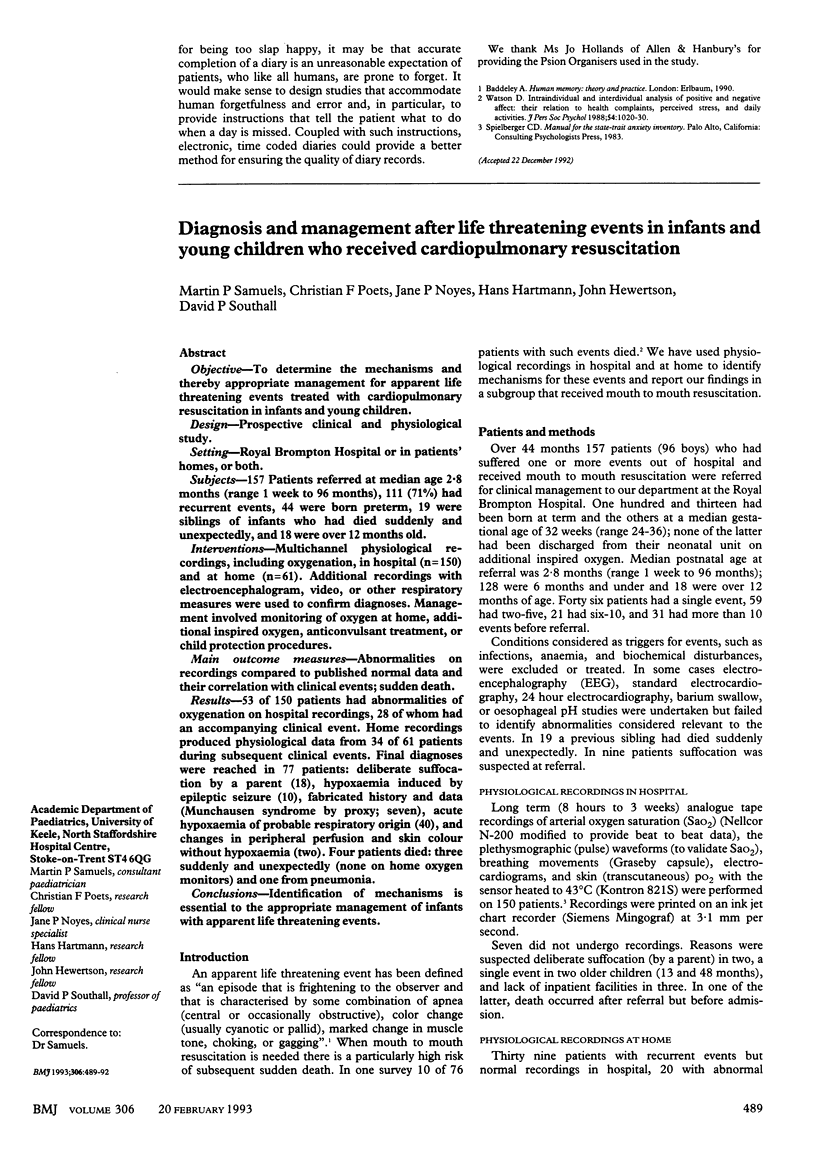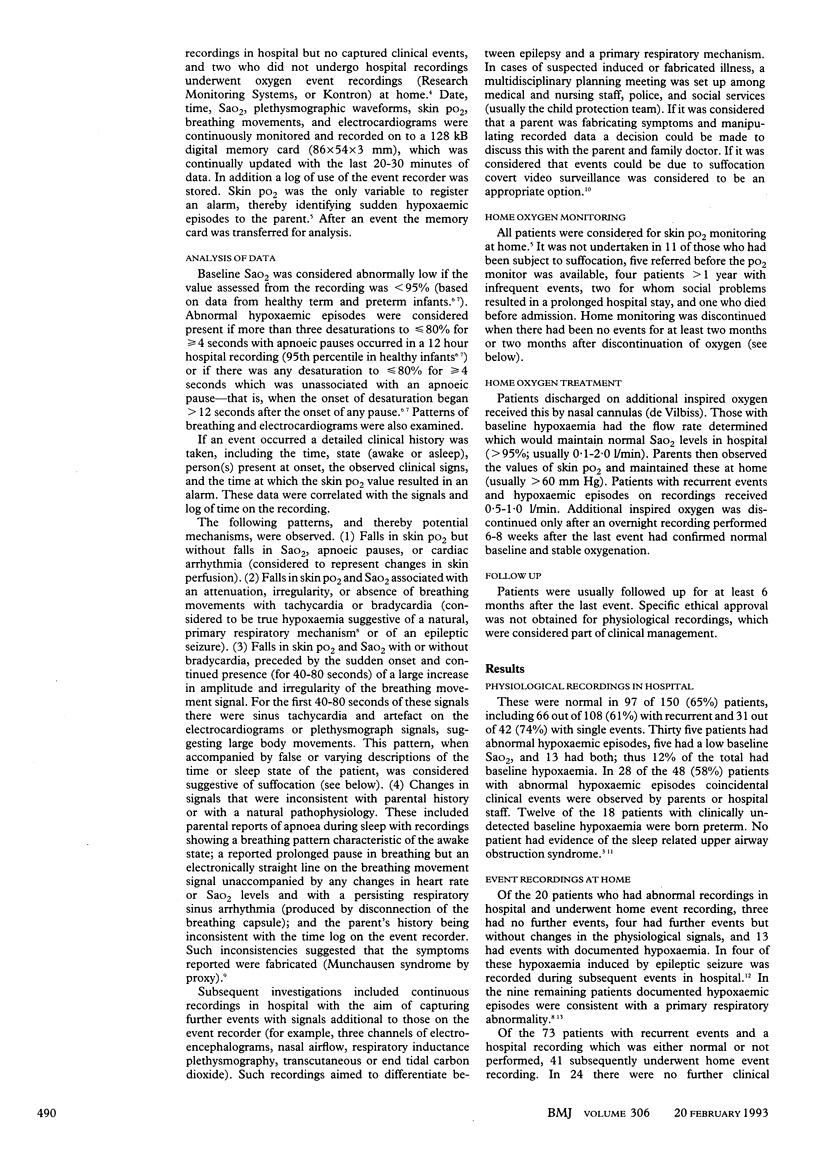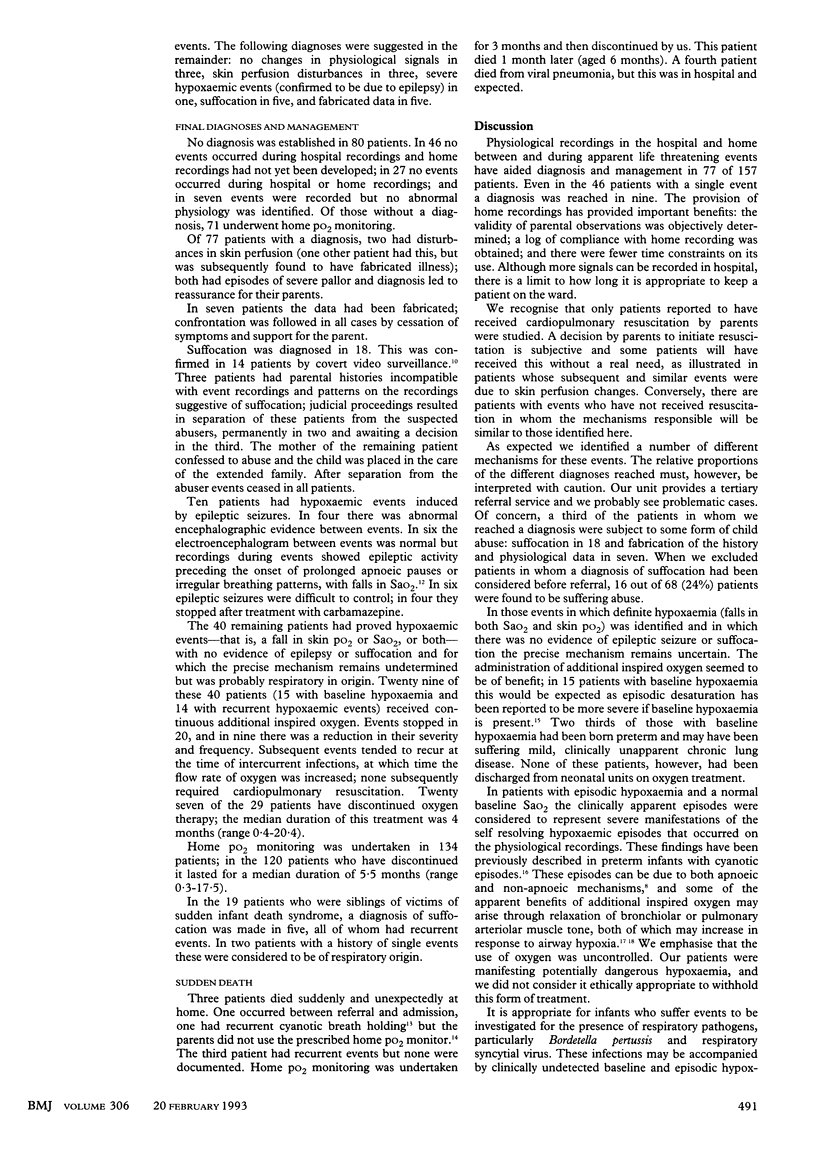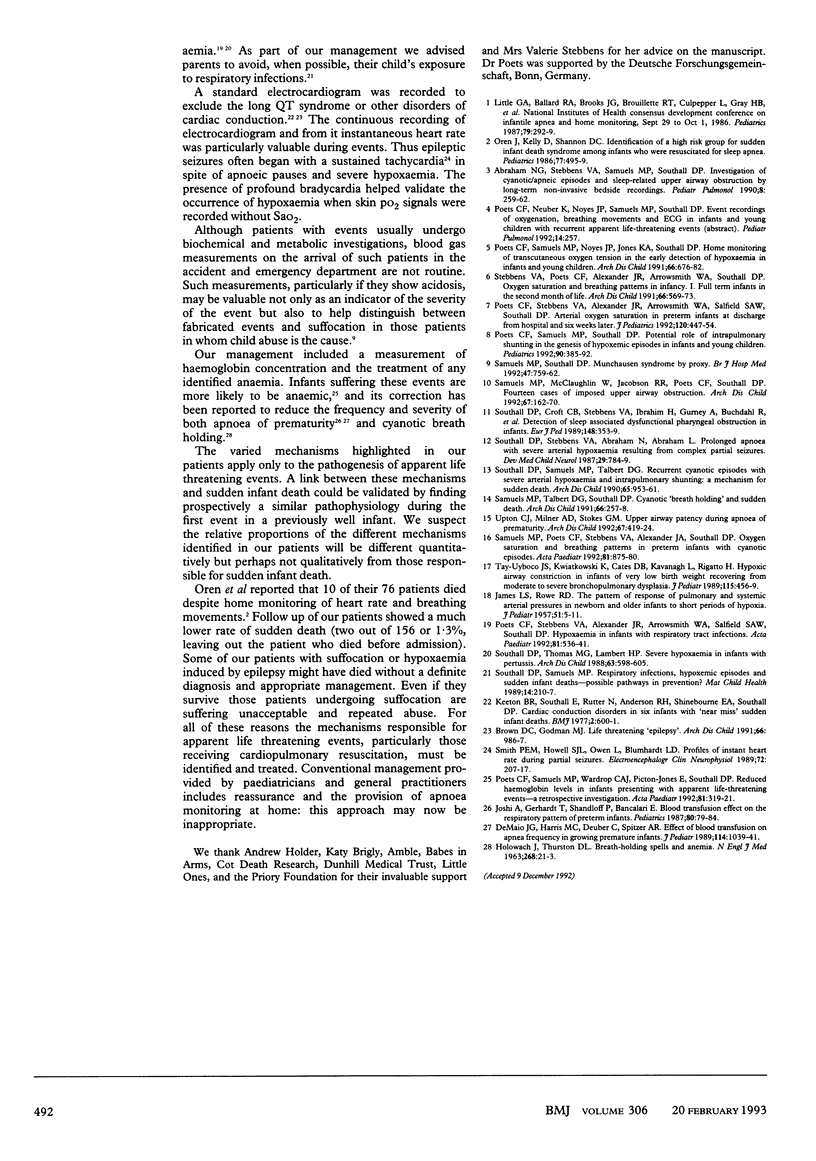Abstract
OBJECTIVE--To determine the mechanisms and thereby appropriate management for apparent life threatening events treated with cardiopulmonary resuscitation in infants and young children. DESIGN--Prospective clinical and physiological study. SETTING--Royal Brompton Hospital or in patients' homes, or both. SUBJECTS--157 Patients referred at median age 2.8 months (range 1 week to 96 months), 111 (71%) had recurrent events, 44 were born preterm, 19 were siblings of infants who had died suddenly and unexpectedly, and 18 were over 12 months old. INTERVENTIONS--Multichannel physiological recordings, including oxygenation, in hospital (n = 150) and at home (n = 61). Additional recordings with electroencephalogram, video, or other respiratory measures were used to confirm diagnoses. Management involved monitoring of oxygen at home, additional inspired oxygen, anticonvulsant treatment, or child protection procedures. MAIN OUTCOME MEASURES--Abnormalities on recordings compared to published normal data and their correlation with clinical events; sudden death. RESULTS--53 of 150 patients had abnormalities of oxygenation on hospital recordings, 28 of whom had an accompanying clinical event. Home recordings produced physiological data from 34 of 61 patients during subsequent clinical events. Final diagnoses were reached in 77 patients: deliberate suffocation by a parent (18), hypoxaemia induced by epileptic seizure (10), fabricated history and data (Munchausen syndrome by proxy; seven), acute hypoxaemia of probable respiratory origin (40), and changes in peripheral perfusion and skin colour without hypoxaemia (two). Four patients died: three suddenly and unexpectedly (none on home oxygen monitors) and one from pneumonia. CONCLUSIONS: Identification of mechanisms is essential to the appropriate management of infants with apparent life threatening events.
Full text
PDF



Selected References
These references are in PubMed. This may not be the complete list of references from this article.
- Abraham N. G., Stebbens V. A., Samuels M. P., Southall D. P. Investigation of cyanotic/apneic episodes and sleep-related upper airway obstruction by long-term non-invasive bedside recordings. Pediatr Pulmonol. 1990;8(4):259–262. doi: 10.1002/ppul.1950080409. [DOI] [PubMed] [Google Scholar]
- Brown D. C., Godman M. J. Life threatening 'epilepsy'. Arch Dis Child. 1991 Aug;66(8):986–987. doi: 10.1136/adc.66.8.986. [DOI] [PMC free article] [PubMed] [Google Scholar]
- HOLOWACH J., THURSTON D. L. Breath-holding spells and anemia. N Engl J Med. 1963 Jan 3;268:21–23. doi: 10.1056/NEJM196301032680105. [DOI] [PubMed] [Google Scholar]
- JAMES L. S., ROWE R. D. The pattern of response of pulmonary and systemic arterial pressures in newborn and older infants to short periods of hypoxia. J Pediatr. 1957 Jul;51(1):5–11. doi: 10.1016/s0022-3476(57)80274-1. [DOI] [PubMed] [Google Scholar]
- Joshi A., Gerhardt T., Shandloff P., Bancalari E. Blood transfusion effect on the respiratory pattern of preterm infants. Pediatrics. 1987 Jul;80(1):79–84. [PubMed] [Google Scholar]
- Keeton B. R., Southall E., Rutter N., Anderson R. H., Shinebourne E. A., Southall D. P. Cardiac conduction disorders in six infants with "near-miss" sudden infant deaths. Br Med J. 1977 Sep 3;2(6087):600–601. doi: 10.1136/bmj.2.6087.600. [DOI] [PMC free article] [PubMed] [Google Scholar]
- National Institutes of Health Consensus Development Conference on Infantile Apnea and Home Monitoring, Sept 29 to Oct 1, 1986. Pediatrics. 1987 Feb;79(2):292–299. [PubMed] [Google Scholar]
- Oren J., Kelly D., Shannon D. C. Identification of a high-risk group for sudden infant death syndrome among infants who were resuscitated for sleep apnea. Pediatrics. 1986 Apr;77(4):495–499. [PubMed] [Google Scholar]
- Poets C. F., Samuels M. P., Southall D. P. Potential role of intrapulmonary shunting in the genesis of hypoxemic episodes in infants and young children. Pediatrics. 1992 Sep;90(3):385–391. [PubMed] [Google Scholar]
- Poets C. F., Samuels M. P., Wardrop C. A., Picton-Jones E., Southall D. P. Reduced haemoglobin levels in infants presenting with apparent life-threatening events--a retrospective investigation. Acta Paediatr. 1992 Apr;81(4):319–321. doi: 10.1111/j.1651-2227.1992.tb12234.x. [DOI] [PubMed] [Google Scholar]
- Poets C. F., Stebbens V. A., Alexander J. R., Arrowsmith W. A., Salfield S. A., Southall D. P. Arterial oxygen saturation in preterm infants at discharge from the hospital and six weeks later. J Pediatr. 1992 Mar;120(3):447–454. doi: 10.1016/s0022-3476(05)80919-9. [DOI] [PubMed] [Google Scholar]
- Samuels M. P., McClaughlin W., Jacobson R. R., Poets C. F., Southall D. P. Fourteen cases of imposed upper airway obstruction. Arch Dis Child. 1992 Feb;67(2):162–170. doi: 10.1136/adc.67.2.162. [DOI] [PMC free article] [PubMed] [Google Scholar]
- Samuels M. P., Poets C. F., Stebbens V. A., Alexander J. A., Southall D. P. Oxygen saturation and breathing patterns in preterm infants with cyanotic episodes. Acta Paediatr. 1992 Nov;81(11):875–880. doi: 10.1111/j.1651-2227.1992.tb12127.x. [DOI] [PubMed] [Google Scholar]
- Samuels M. P., Southall D. P. Munchausen syndrome by proxy. 1992 May 20-Jun 2Br J Hosp Med. 47(10):759–762. [PubMed] [Google Scholar]
- Samuels M. P., Talbert D. G., Southall D. P. Cyanotic 'breath holding' and sudden death. Arch Dis Child. 1991 Feb;66(2):257–258. doi: 10.1136/adc.66.2.257. [DOI] [PMC free article] [PubMed] [Google Scholar]
- Smith P. E., Howell S. J., Owen L., Blumhardt L. D. Profiles of instant heart rate during partial seizures. Electroencephalogr Clin Neurophysiol. 1989 Mar;72(3):207–217. doi: 10.1016/0013-4694(89)90245-9. [DOI] [PubMed] [Google Scholar]
- Southall D. P., Croft C. B., Stebbens V. A., Ibrahim H., Gurney A., Buchdahl R., Warner J. O. Detection of sleep associated dysfunctional pharyngeal obstruction in infants. Eur J Pediatr. 1989 Jan;148(4):353–359. doi: 10.1007/BF00444133. [DOI] [PubMed] [Google Scholar]
- Southall D. P., Samuels M. P., Talbert D. G. Recurrent cyanotic episodes with severe arterial hypoxaemia and intrapulmonary shunting: a mechanism for sudden death. Arch Dis Child. 1990 Sep;65(9):953–961. doi: 10.1136/adc.65.9.953. [DOI] [PMC free article] [PubMed] [Google Scholar]
- Southall D. P., Stebbens V., Abraham N., Abraham L. Prolonged apnoea with severe arterial hypoxaemia resulting from complex partial seizures. Dev Med Child Neurol. 1987 Dec;29(6):784–789. doi: 10.1111/j.1469-8749.1987.tb08824.x. [DOI] [PubMed] [Google Scholar]
- Southall D. P., Thomas M. G., Lambert H. P. Severe hypoxaemia in pertussis. Arch Dis Child. 1988 Jun;63(6):598–605. doi: 10.1136/adc.63.6.598. [DOI] [PMC free article] [PubMed] [Google Scholar]
- Stebbens V. A., Poets C. F., Alexander J. R., Arrowsmith W. A., Southall D. P. Oxygen saturation and breathing patterns in infancy. 1: Full term infants in the second month of life. Arch Dis Child. 1991 May;66(5):569–573. doi: 10.1136/adc.66.5.569. [DOI] [PMC free article] [PubMed] [Google Scholar]
- Tay-Uyboco J. S., Kwiatkowski K., Cates D. B., Kavanagh L., Rigatto H. Hypoxic airway constriction in infants of very low birth weight recovering from moderate to severe bronchopulmonary dysplasia. J Pediatr. 1989 Sep;115(3):456–459. doi: 10.1016/s0022-3476(89)80855-8. [DOI] [PubMed] [Google Scholar]
- Upton C. J., Milner A. D., Stokes G. M. Upper airway patency during apnoea of prematurity. Arch Dis Child. 1992 Apr;67(4 Spec No):419–424. doi: 10.1136/adc.67.4_spec_no.419. [DOI] [PMC free article] [PubMed] [Google Scholar]


